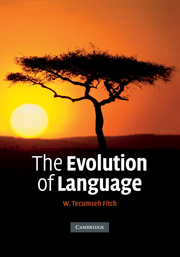Book contents
- Frontmatter
- Contents
- List of figures
- Acknowledgments
- Introduction
- SECTION 1 THE LAY OF THE LAND
- SECTION 2 MEET THE ANCESTORS
- SECTION 3 THE EVOLUTION OF SPEECH
- 8 The evolution of the human vocal tract
- 9 The evolution of vocal control: the neural basis for spoken language
- 10 Models of the evolution of speech and phonology
- SECTION 4 EVALUATING PHYLOGENETIC MODELS OF LANGUAGE EVOLUTION
- Glossary
- Appendix: species names
- References
- Author index
- Subject index
- Species index
9 - The evolution of vocal control: the neural basis for spoken language
Published online by Cambridge University Press: 05 June 2012
- Frontmatter
- Contents
- List of figures
- Acknowledgments
- Introduction
- SECTION 1 THE LAY OF THE LAND
- SECTION 2 MEET THE ANCESTORS
- SECTION 3 THE EVOLUTION OF SPEECH
- 8 The evolution of the human vocal tract
- 9 The evolution of vocal control: the neural basis for spoken language
- 10 Models of the evolution of speech and phonology
- SECTION 4 EVALUATING PHYLOGENETIC MODELS OF LANGUAGE EVOLUTION
- Glossary
- Appendix: species names
- References
- Author index
- Subject index
- Species index
Summary
Neural control over speech: the central evolutionary event
The comparative data reviewed in Chapter 8 suggest that a normal mammalian vocal tract could generate many of the sounds of speech without reconfiguration and, by lowering the larynx, could presumably even create the point vowels. And yet, speech is special: it is a complex, learned signaling system involving rapid formant transitions, and the rapid movements of the tongue and lips used in speech have few apparent analogs in the animal world. These characteristics do not appear to result from differences in vocal morphology alone, strongly suggesting that some aspect of our neural endowment is critical to the evolution of speech. The ability that differentiates humans unambiguously from chimpanzees (and apparently all other nonhuman primates) is our capacity for complex vocal imitation, a cognitive and neural capacity that is crucial for human speech (Fitch, 2000b). Given the importance of this neural aspect of spoken language, I will explore it from all of Tinbergen's angles in this chapter: mechanism, ontogeny, phylogeny, and function.
Evolving learned vocalizations: phylogeny and function
From a comparative perspective, a number of distinctions are important in discussions of vocal learning (Janik and Slater, 1997). First, we can distinguish between “vocal learning” per se, which involves changing some acoustic aspect of the call itself (or “production learning”; Janik and Slater, 2000), and call usage learning, the ability to control the production of a pre-exisiting call, or to associate it to new contexts.
- Type
- Chapter
- Information
- The Evolution of Language , pp. 338 - 363Publisher: Cambridge University PressPrint publication year: 2010



